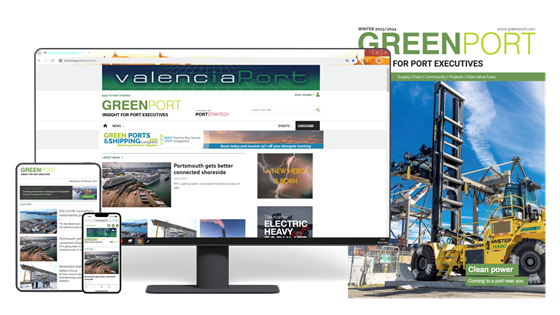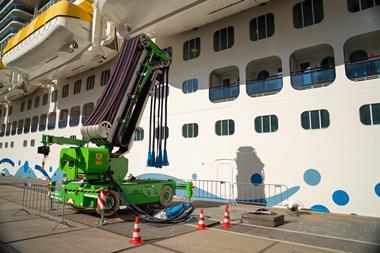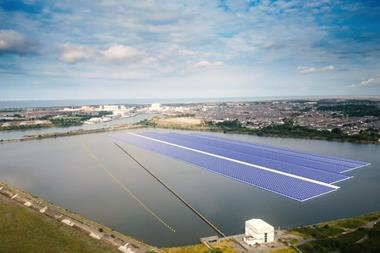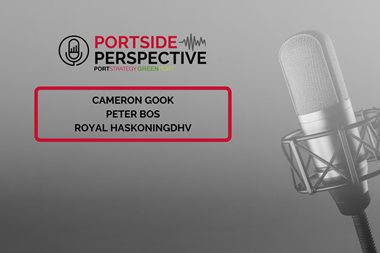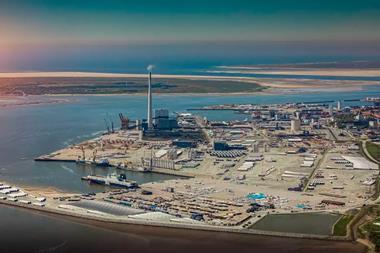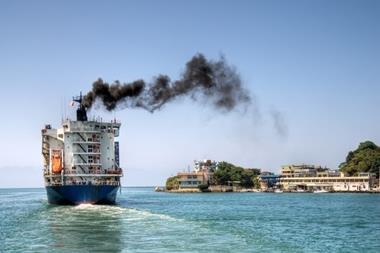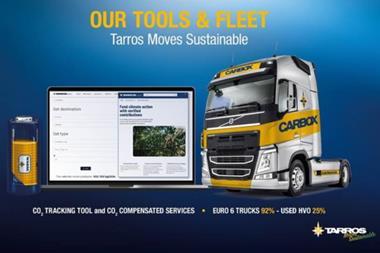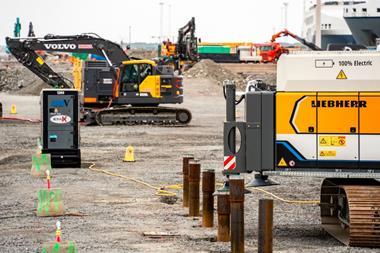The Solent is at the heart of the UK’s maritime sector and is helping lead the way when it comes to decarbonisation, but there’s still plenty more work to do.
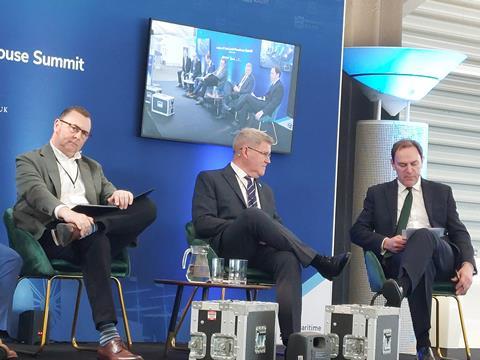
That was the message from the first day of the inaugural Maritime UK Solent Coastal Summit conference held at ABP Southampton’s Ocean Cruise Terminal from 26 to 27 March 2025.
And it was a timely discussion following the launch of the new UK Government Maritime Decarbonisation Strategy this week. There was plenty to talk about.
A changing world
Alastair Welch, port director, ABP Southampton, opened the summit by talking about the Solent as the heart of the UK maritime sector.
But the challenge he said is to meet decarbonisation targets and stay ahead of the competition.
“The world is changing and we have to innovate and adapt. We have to work hard to keep our customers,” he said.
“For both cruise and containers space is a challenge. World politics have changed trade. For example, the Red Sea issues means that ships now come directly to the UK from Singapore, meaning they are bigger and heavier.”
“Security consents are taking too long and we risk becoming uncompetitive. World events could leave us behind if we’re not careful.”
Mr Welch said that sustainability is not going to go away but presently operators are not being funded or incentivised as they are in Europe and therein lies a challenge.
Consequently, ABP Southampton has worked hard to decarbonise under its own steam and now generates half of its power using solar. It’s also had a huge push of volume onto rail.
“We had the first commercial shore power solution in the UK but to do more we need more power and the means to achieve more,” he said.
And that’s something that needs to be done on a national scale.
Timely opportunity
Anne-Marie Mountifield, chair, Maritime UK Solent, explained the importance of the summit.
“The summit is a major opportunity for us to come together to acknowledge the pivotal role the sector is playing in the region and nationally,” she said.
“As a sector, maritime is undersold so we all need to bang the drum loud so we can be heard.”
The marine sector she said now provides 138,000 jobs in the region and even with the rise of automation, employment has grown in the sector by 6.5% since 2019, bucking the trend in other industries. Productivity is up by 20% too.
“Reskilling and nurturing talent will be key going forward,” Ms Mountifield added.
“Maritime has previously had a ‘Cinderella’ factor but now I think it is finally coming of age.”
Paul Ludlow, president Carnival UK and P&O Cruises, explained the importance of the cruise sector to the Solent area.
In 2023, there were around 460 cruise vessel calls at Southampton annually with 2.6 million passengers generating more than GB£1 billion for the local and regional economy.
Despite these positives, the cruise industry is still getting a bad press when it comes to the environment but it’s something Carnival is working hard to turn around.
“We are taking action to reduce our impact on the environment to deliver positive change,” he said.
“Our operations in Southampton and beyond are having a huge impact on the local economy and beyond nationally.”
He added that Carnival expects to publish a third party validated impact report shortly.
Green strategy
The morning’s clean maritime seminar revolved around a discussion on the new UK Maritime Decarbonisation Strategy.
Some of the speakers (and delegates) had input into the strategy itself.
Charlie Field, head of engineering and estates, Wightlink, was keen to discuss the likely impact of stricter regulations under the UK Emissions Trading Scheme (UK ETS).
“There will be increased costs to us as a ferry operator but whatever we do in terms of decarbonisation, there is a pay-off,” he said. “But the pathway has be made as smooth and as tax neutral as possible.”
When it comes to alternative fuels, he said that the biggest challenge for Wightlink as a ferry operator is the maintenance burden, particularly when it comes to biofuels.
“Storage is our primary concern, along with the infrastructure not being available, there’s no answer at the moment because the logistics just aren’t there.”
With regards to electrification, Mr Field said that Wightlink is taking the hybrid approach to decarbonisation with its vessels, because as things stand there just isn’t sufficient grid power supply to ports.
Eugene Bari, founder and CEO of Ecomar Propulsion, spoke about the impacts of the new policy both as an SME and a electric and hybrid hydrogen marine propulsion system manufacturer.
“Early adopters of alternative fuels will be at an advantage,” he said.
“For example, they may be able to look at selling carbon credits which could be an incentive to adopt these fuels and decarbonise. But we need to move now towards rapid deployment and this needs funding.”
He pointed out that major OEMs give SMEs finding to progress developments already, but the problem is with actually getting technologies to market.
“Let us cut the bread because we have made the loaf,” he said.
Rounding-up, the speakers talked about what is needed to hit future decarbonisation targets.
They summed up that the big challenges are planning timeframes and space constraints for alternative fuels infrastructure and for electrification, it’s grid infrastructure.
But they pointed out that end users will help drive things forward to solve these problems, along with an increase in investor potential.
The boom in data analysis and automation is also steering the industry rapidly towards efficiency targets.
Government steer
Mike Kane, UK Maritime Minister, made an appearance at the event as part of his road trip to promote the launch of the new UK Maritime Decarbonisation Strategy.
“We now have a clear plan for decarbonisation aligned with IMO goals. With everyone united by a common goal we will succeed.”
He called the industry “the eyes and ears on the ground” and said that the government will keep learning and listening to the industry as it moves towards its decarbonisatiuon targets.
But he admitted that what the industry needs is more investment.
He said that the government has announced a further GB£30m investment into the UK shore power programme and another round of the Clean Maritime Demonstration Competition (CDMC), which aims to nurture start-ups and commercialise green innovation.
“Its been a long time coming but what we are doing with this strategy is doing away with the dither and helping bring the industry certainty,” he said.
Exploring progress
The afternoon panel discussion was all about exploring how ports are already making progress on decarbonisation.
Steve Watkyns, technical director, Portsmouth International Port, spoke about the success of Portsmouth’s Sea Change electrification project to design, build and operate a shore power system across the three busiest berths at Portsmouth International Port.
But he said plenty of obstacles remain for widespread adoption of electrification in the UK.
“For us, the cost of electricity needs to be addressed, high costs being passed on to our customers, especially our ferry customers is not feasible and we also can’t justify why our electricity costs are three times as high as on the Continent,” he said.
Clive Thomas, commercial director at Solent Stevedores, agreed. He said that most of the company’s port equipment fleet is now electrified, but they’re still having to work around problems with charging and cost.
He said that 24/7 operations need fast charging points or other measures to be put in place so that companies do not have to suffer any losses for downtime. But he questioned who should foot the cost.
John Trenchard, vice president of commercial and supply chain UK, DP World, said that it is working around the funding issue by charging a premium for electrical infrastructure and by charging a small amount on each box, which has helped accelerate its transition from diesel to HVO fuelled port equipment.
He said that these charges are built into the port tariff structure, but they’re not deterring customers who are making a conscious choice to get greener by actively choosing to use near net-zero terminals.
Mr Trenchard outlined the progress the operator is making at Southampton and London Gateway, with a particular emphasis on its achievement of approaching net-zero operations.
The operator has largely done this with a two-fold approach. Its been incentivising rail since 2023 and just last month reached its 100,000 incremental container transported by rail.
It has also introduced carbon inset credits for every container for an initial six months from 1 January 2025. Registered importers moving cargo through DP World UK ports at Southampton and London Gateway will earn a 50 kg CO₂e inset certificate per import laden container. And its been very successful so far.
“We work on the notion that we need the right type of electrons, the right colour and the right price,” he said.
Ashley Jenkins, director, Whitaker Tankers, brought the tanker view to the discussion.
“The change in the last ten years has been amazing. Biofuels are an important element for us in a multi-fuel future.”
“But not one fuel fits all and there will be a gradual transition over the next few decades which will still be underpinned by hydrocarbons,” he said.
Charles Haskell, senior director decarbonisation, Carnival UK, told the audience that Carnival’s focus is on reducing energy consumption onboard and it has made good progress.
“We operate floating cities with a high energy demand so our focus is on reducing energy levels. We’ve made massive strides in five years, we’ve reduced our carbon intensity by 20% since 2019.”
He said that from an operator’s point of view, the ships have the technology but the port infrastructure is not keeping up.
This isn’t just a cruise issue, but also affects the container and ferry segment where there is a need to aggregate demand for electricity and shore power.
Mr Haskell said the UK should look to Europe where shore power is incentivised under the Fit For 55 package. He used the example of Malta where in the near future the port will be able to have five ships plug into shore power at any one time.
Summing up
By way of conclusion, the speakers echoed the earlier request that the government “take the shackles off” to allow for more rapid decarbonisation.
Mr Watkyns, Portsmouth Internation Port, said: “We need funding, we’re going to be in the position shortly that we have the two largest shorepower operating systems (Portsmouth and ABP Southampton) shortly and we need the rest of the UK to catch up with where the Solent is now.”
Mr Trenchard, DP World, meanwhile called for more support for innovation.
He said that the funding issue can be solved but it’s uncertainty surrounding residual equipment that cannot.
“Assurance on residual asset values will take away the uncertainty and encourage more and faster investment in green technology,” he said.
Lastly, Mr Welch, ABP Southampton, called for more joined-up thinking from the government when it looks at and involves the marine sector in strategy and policy going forward.
“We know how valuable it is to always look at the whole picture and not just individual elements,” he said.
The Coastal Powerhouse Summit is Maritime UK Solent’s flagship event, organised in partnership with Associated British Ports (ABP) and Carnival UK.


